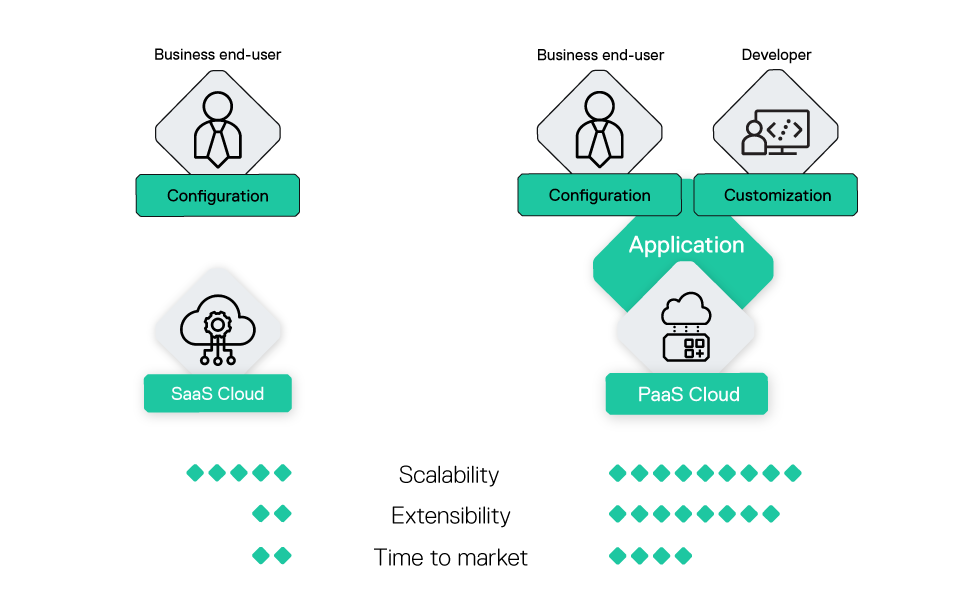Cloud
PaaS, SaaS, or Both?
The usage of cloud computing has become a norm for enterprise businesses. While the benefits of running your software in public clouds (AWS, AZURE, GCP, etc.) vs. in your own data center are obvious, businesses still have an essential decision to make about the best cloud deployment model.


The usage of cloud computing has become a norm for enterprise businesses. While the benefits of running your software in public clouds (AWS, AZURE, GCP, etc.) vs. in your own data center are obvious, businesses still have an essential decision to make about the best cloud deployment model; whether that is PaaS, SaaS, or both.
For enterprise-grade digital commerce, this choice is between Software as a Service (SaaS) or Platform as a Service (PaaS). The decision is not straightforward as there are many criteria to consider, and each model has its pros and cons. We will discuss the main differences between SaaS and PaaS and provide you guidance on how to evaluate which model is the best for your Digital Commerce business.
Let’s start with definitions.
SaaS
SaaS (Software-as-a-Service ) is the most inclusive solution. The entire software system is developed, deployed, and maintained by the vendor. Business users can access the application directly from a web browser (or any other device) from almost anywhere and use it as is or configure it for their specific needs.
SaaS eliminates the need to install applications and streamlines their maintenance and support. Everything (the entire stack) is managed by SaaS vendors: applications, data, middleware, operating system, virtualization, servers, backups, and networking. They ensure security, scalability, and a high level of availability for your application. SaaS, by definition, can’t provide you with full flexibility when it comes to customizations, extensions or simply building differentiative functionality and business logic outside of configuration and plugins only.
PaaS
PaaS (Platform-as-a-Service) provides your team with a solution to build, test, and run applications on top of a fully managed infrastructure, platform, and application stacks. Developers focus on developing or extending the custom business logic on top of the fully managed application core and ideally within the Service Level Agreements (SLAs) of the entire platform; while a PaaS vendor provides the infrastructure, platform, core application, middleware, servers, the development/staging/production environments, and storage. You will also get access to a self-service portal to manage infrastructure, deploy your code, and monitor the application’s performance.
With PaaS, the development of custom applications (or extensions) is quick, simple, and cost-effective. Applications using PaaS benefit from cloud characteristics such as scalability, security, high availability, and multi-tenancy. Benefits are further amplified if the selected PaaS vendor has experience with the application you are using. PaaS does not mean you have to develop the entire application layer yourself.
An e-commerce platform deployed in the PaaS model provides all generic features that can be configured or extended in a similar way as one would do with the SaaS software; Including full availability of frontend APIs in a headless context. The difference comes when a business needs to implement unique, differentiative features without waiting for the platform provider. PaaS imposes no limits on innovation and customization – you can build what you need when you need it!

There are many factors to consider when choosing a cloud deployment model:
- The total cost of ownership (TCO) of the solution, including all licensing and services fees and the cost to develop and operate the system.
- Time to value . If functionality offered by a SaaS vendor fully meets your requirement, it will be faster to start. However, if you need to implement precise requirements that a SaaS vendor does not fully support and which go beyond the experience-only level, enabled by many API-based & headless systems, you will reach your goal more quickly on PaaS.
- How does the functionality offered by the vendor satisfy your business requirements ? In mature commoditized markets, SaaS vendors have had time to develop solutions that fit the requirements of almost all customers in their target segment. For example, that is the case for standard pure online e-commerce solutions for small and medium sellers in established verticals with less sophisticated business models like for, example, B2C Fashion Retail vs. sophisticated and not yet commoditized verticals like B2B, Enterprise Marketplaces, Online Grocery Deliveries, Manufacturing, IoT commerce, and others that require, rather, a PaaS approach.
- On the other hand, if you are in a fast-evolving market and need to innovate at a neck-breaking speed, the ability to customize beyond the experience and API layers and the ability to add new functionality when you need it should be an important factor in your decision.
- Sophisticated vs. standard (commodity) business models. The pace of innovation in digital commerce continues to accelerate with new technologies opening new business opportunities. Businesses are experimenting with new ways of selling online, attracting customers, collecting and using data, and enabling new business models. Here are several examples of when more sophisticated (non-commoditized) solutions that only the PaaS model can support are required:
a) Previously, many products were considered too complex to be offered online. Pioneering companies are changing this now by building custom configurators to assist customers in designing the exact products they need and supporting them by enabling online collaboration with the in-house sales team.
b) While many Digital Commerce platforms can support a pickup in-store, businesses continue to innovate with omnichannel delivery by offering pickup in a variety of different locations: self-service lockers, curbside pickup, post offices, retail location of business’ partners, gas stations, etc. Each type of location has different capacities and business rules defining what products are accepted, how long they can be stored, and what orders can be routed there.
c) Another example of a sophisticated digital commerce solution will be an implementation for a large international business that has both online stores and an extensive network of retail locations. Customers in the online shop should see product availability and prices for both buying online and in a store close to their location, and a manager of retail location should be able to adjust inventory, services available at the location, promotions, and more.
In such cases, the ability to customize does matter, and the PaaS cloud model with its unlimited flexibility makes sense and is a better fit.
- It is also essential to consider the required skills and expertise to develop and operate the application. Can you rely on an internal team or an implementation partner for this?
When to Use SaaS
SaaS platforms are ideal when you want an application to run smoothly and reliably with minimal effort in exchange for limited abilities and customization potential from your side. It is a good fit when integration requirements are met with out-of-box solutions, and the functionality provided by the SaaS vendor is sufficient. That is usually the case for companies in an established mature market that allows innovating at the pace of your selected SaaS vendor. Low upfront cost and reduced time to benefits are deciding factors in selecting the SaaS cloud deployment for commoditized digital commerce models.
It is mainly suited for unsophisticated, B2C environments, especially around retail-only use cases aiming to build simple online shops. However, it would be best to keep in mind that SaaS makes it harder to implement custom workflows and business logic. You are dependent on the provider to make improvements in features and integration options.
When to Use PaaS
PaaS is best suited for customers with sophisticated requirements operating in digitally fast-growing environments. Since these verticals are non-commoditized, they require a higher degree of customization and integration flexibility. In the digital commerce and transactional domains, PaaS is best suited for large, global manufacturers, wholesalers, marketplaces, and retailers with complex transactional use cases and businesses in growing verticals like Food & Groceries, Pharma, Medtech, Gaming, Education or B2B Distributors.
It is the best fit for manufacturers that need to balance multiple distribution channels with a direct-to-consumer approach, B2B businesses that have complex contractual arrangements with their customers, and companies in regulated environments.
PaaS offers the most cost and time-effective way for developers to create an utterly unique application . PaaS allows the developer to focus on the business logic of app development, as opposed to routine tasks such as managing updates or security patches. It imposes no customization or integration limits, gives developers complete control on the application level while ensuring maximum scalability and availability.
The PaaS cloud model also allows more flexibility in defining Service Level Agreement (SLA). Different businesses have different system usage patterns, pick load times, and SLA requirements. In the PaaS model, deployment architecture and SLAs can be customized to fit each unique use case.
Let’s explore further how PaaS enables developers to be more productive:
Very specialized infrastructure and database expertise are needed to deploy and manage applications in the cloud successfully, which can easily overwhelm small development teams and leave them with insufficient time to develop their applications.
With PaaS, developers do not need to understand containers, vertical and horizontal scaling, cloud cost optimizations, learn how to build and optimize CI / CD pipelines, consolidate and analyze logs, or set up alerts and monitoring.
With PaaS, the development and operational environments become automated and abstracted to the point that your teams no longer need a dedicated DevOps team or special skills to deploy and manage applications. That means that development teams can better focus their resources on higher-value tasks like coding application logic.

Spryker’s PaaS Solution: PaaS+
Since nobody knows the system better than the company that has developed it, using it also as a PaaS provider makes sense. That will ensure the development of new functionality is tightly coordinated with PaaS support. As a result, you will get the best possible product experience when it comes to deployment, scalability, and security.
SLAs, deployment architecture, data storage location, upgrade scope, and schedule are designed to fit each customer’s unique requirements.
All PaaS vendors provide upgrades to the underlying OS, application servers, databases, and middleware layers. However, Spryker is pushing the PaaS concept further with our PaaS+ cloud delivery. PaaS+ provides all of the features you expect from a cloud platform, but with additional services, such as Spryker Code Upgrader.
Spryker Code Upgrader helps minimize engineer maintenance efforts by providing semi-automatic upgrades for minor and patch SCOS releases. It also provides guidelines for new code being integrated into a platform, offering suggestions to ensure this code is compliant.
The Spryker PaaS+ solution is best suited for customers in digitally fast-growing environments with (by definition) more sophisticated requirements. It is a fully managed cloud offering with an end-to-end SLA which gives complete control of the application layer with no customization and integration limits while providing maximum scalability and availability. Spryker PaaS+ works best for sophisticated transactional use cases in B2B, Unified Commerce, Enterprise Marketplaces, and B2C.
Selecting the PaaS cloud deployment model for your digital commerce platform does not mean SaaS solutions are out of the picture. In a complex e-commerce environment, a business usually has more than one application to run. That is especially true if you are following the Composable Commerce architecture.
So, while your e-commerce system uses PaaS, following the guidelines outlined above, you may select a SaaS solution for your PIM, CMS, or Loyalty program components.